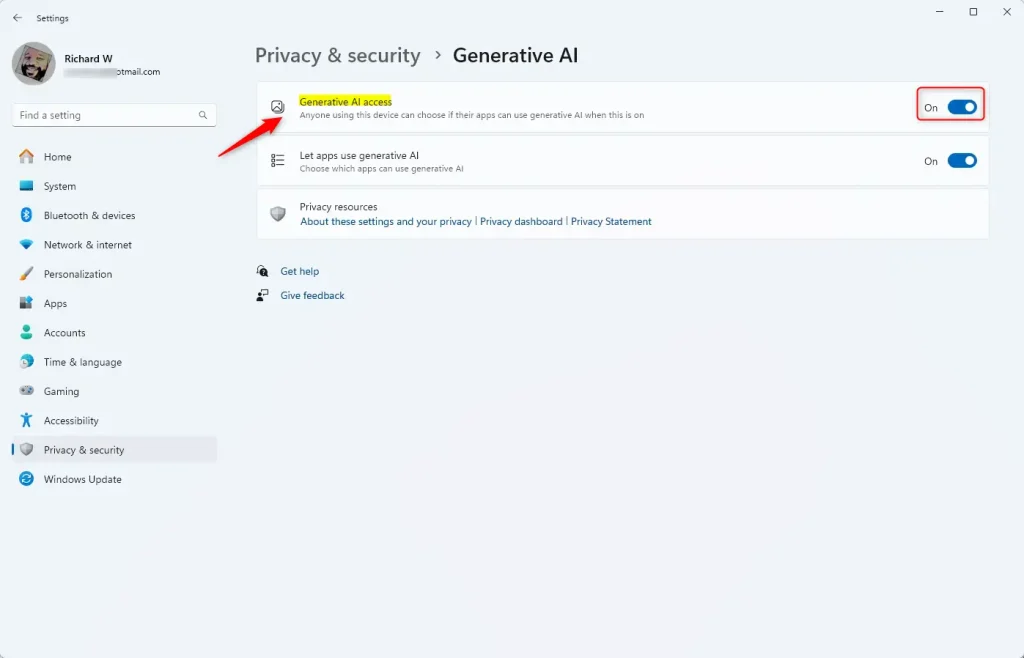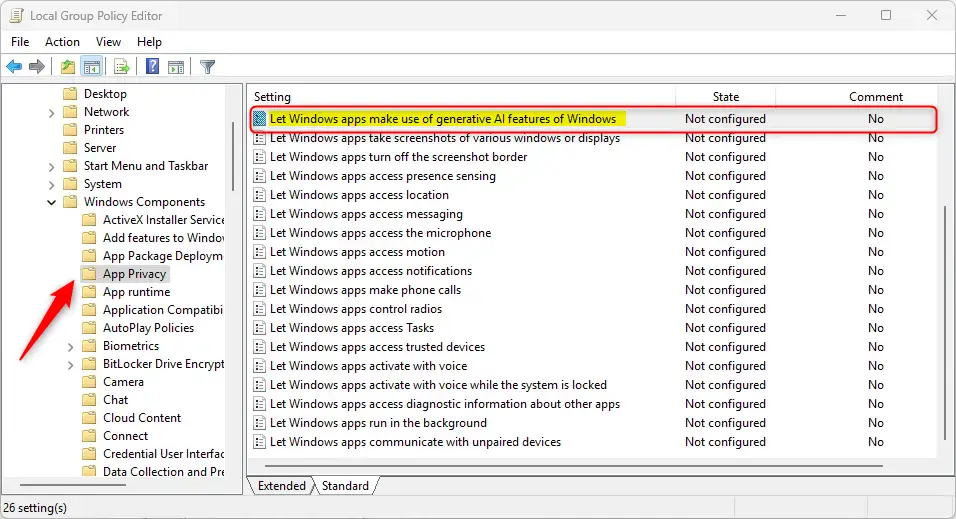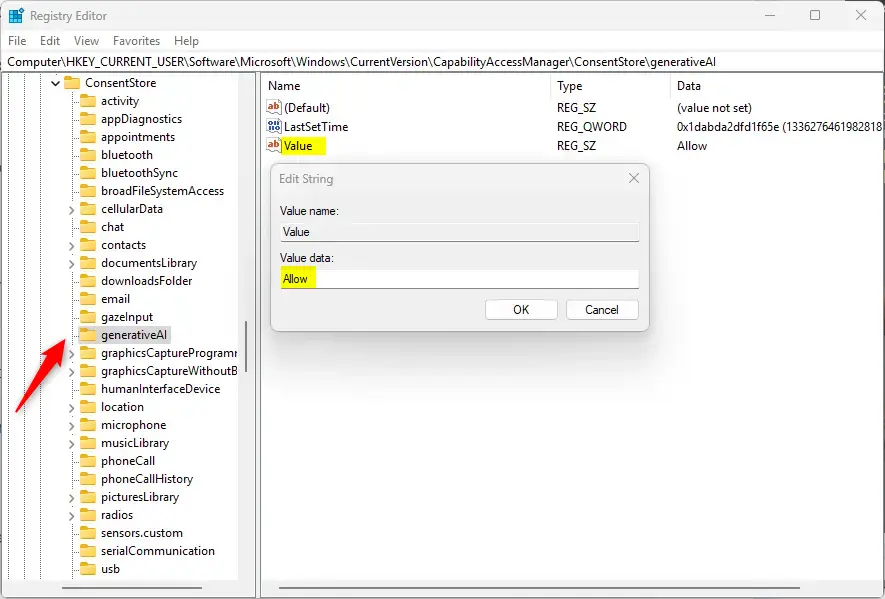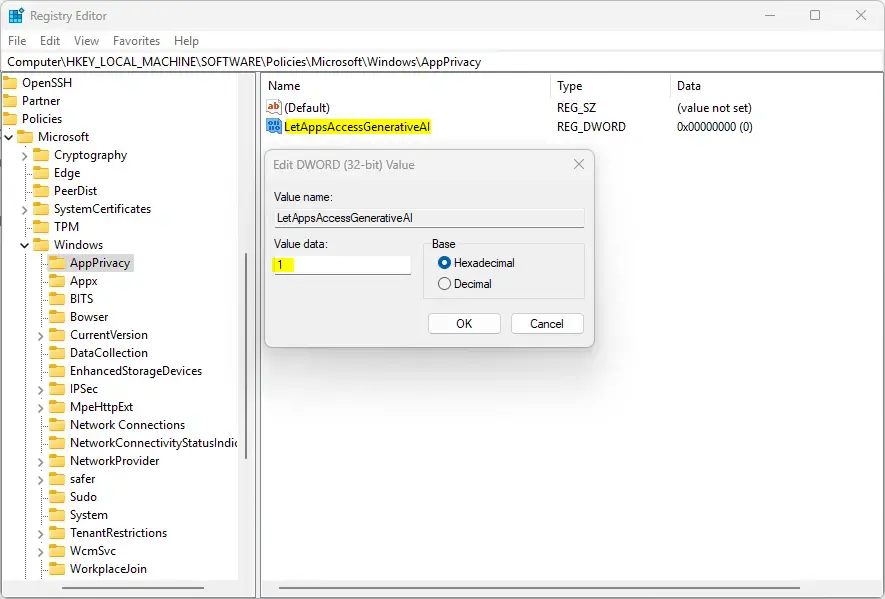This article explains enabling or disabling app access to Generative AI in Windows 11.
App access to generative AI in Windows refers to the capability for applications to utilize generative AI within Windows. This functionality allows apps to harness the power of generative AI for various purposes, such as image generation, content creation, or predictive modeling.
Starting with Windows 11 build 26236 (Canary), Microsoft added a new Generative AI section to the Privacy & security settings page, allowing users to control app access to the new generative AI feature.
The steps below walk you through enabling or disabling app access to the new generative AI feature in Windows 11.
Turn on or off app access to generative AI in the Settings app
As mentioned above, a new toggle button was recently added to enable or disable app access generative AI in the Settings app.
Here’s how to do it.
First, open the Windows Settings app.
You can do that by clicking on the Start menu and selecting Settings. Or press the keyboard shortcut (Windows key + I) to launch the Settings app.
When the Setting app opens, click the Privacy & security button on the left and select the Generative AI tile on the right to expand it.

Select the “Generative IA access” Tile on the Generative AI settings page. Then, toggle the switch button to the On or Off position to enable or disable for all users.

Select the “Let app use generative AI” tile to choose which app can use generative AI. When generative AI access is enabled, you can expand this tile and select or deselect individual apps that can use generative AI.

Close the Settings app when you are done.
Enable or Disable app access to generative AI for all users using the Local Group Policy Editor
Another way to enable or disable app access to generative AI for all users is to use the Local Group Policy Editor.
First, open the Local Group Policy Editor (gpedit.msc). (Search for “Edit group policy”) on the Start menu.
Then, navigate the folders below:
Computer Configuration -> Administrative Templates -> Windows Components -> App Privacy
In the App Privacy details pane on the right, locate and double-click the “Let Windows apps make use of generative AI features of Windows” settings.

On the “Let Windows apps make use of generative AI features of Windows” window, set the option to Not Configure, Enabled, or Disabled.
- Not Configured (default)
- Enabled – Under Options, select one of the following:
- Force Allow – Windows apps can use generative AI features of Windows, but employees in your organization cannot change it.
- Force Deny – Windows apps are not allowed to use generative AI features of Windows, and employees in your organization cannot change it.
- Disabled – If disabled or not configured, users decide whether Windows apps can use Windows generative AI features using step one.

Click OK to save your changes. You may have to reboot your device to apply the settings.
Turn on or off app access to generative AI using the Windows Registry Editor
Yet another way to enable or disable app access to the generative AI feature in Windows is to use the Windows Registry editor.
First, open the Windows Registry editor as administrator.
Then, navigate to the registry key below.
Computer\HKEY_CURRENT_USER\Software\Microsoft\Windows\CurrentVersion\CapabilityAccessManager\ConsentStore\generativeAI
Next, double-click the “Value” String Value (REG_SZ) name on the generativeAI key’s right pane to open it.
Then, type Allow to turn on app access to the generative AI feature in Windows. Type Deny to turn off app access to the generative AI feature.
If you do not see the “Value” item, right-click a blank area and create a new String Value registry item.
Then, type “Value” and enter Allow or Deny to enable or disable app access to generative AI for the current user.

Enable or disable app access to generative AI for all users
Use the steps below to enable or disable app access to generative AI for all users.
Navigate to the registry key below.
Computer\HKEY_LOCAL_MACHINE\SOFTWARE\Policies\Microsoft\Windows\AppPrivacy
Next, double-click the LetAppsAccessGenerativeAI (DWORD) 32-bit Value name on the AppPrivacy key’s right pane to open it.
Then, type 1 to enable app access to generative AI. Type 2 to disable app access to generative AI.
If you do not see the “LetAppsAccessGenerativeAI” item, right-click a blank area and create a new String Value registry item.
Then, type “Value” and enter 1 or 2 to enable or disable app access to generative AI for all users.

Save your changes and restart your computer.
That should do it!
Conclusion:
- Windows 11 now offers a new Generative AI feature that allows apps to leverage the power of generative AI for various tasks.
- Users can easily enable or disable app access to generative AI through the Settings app, Local Group Policy Editor, and Windows Registry Editor.
- The availability of multiple methods provides flexibility in managing app access to generative AI based on user preferences or organizational requirements.
- Whether through the Settings app, Group Policy Editor, or Registry Editor, controlling app access to generative AI is now a straightforward process in Windows 11.

Leave a Reply